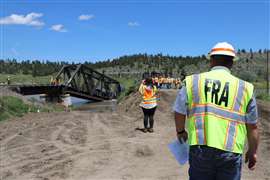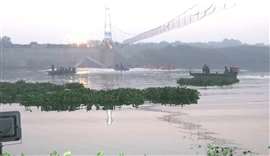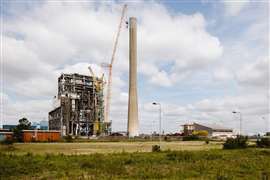How climate change is taking its toll on bridges
10 August 2023
A spate of high-profile bridge collapses have hit the headlines around the world this year, killing hundreds and causing serious infrastructure damage. How much is climate change to blame and what can be done to prevent more bridges from collapsing? Lucy Barnard reports.
 A crew works at the site of a derailment inside Yellowstone River waters following the collapse of the bridge in Reed Point, Montana, U.S. Photo: Senator Steve Daines/via REUTERS
A crew works at the site of a derailment inside Yellowstone River waters following the collapse of the bridge in Reed Point, Montana, U.S. Photo: Senator Steve Daines/via REUTERS
It’s easy to spot the cleanup crews at the site of the Montana Rail Link bridge collapse near the hamlet of Reed Point. They stand out as dots of fluorescent yellow, orange and pink against the startling blues and greens of the Montana hills.
More than month after the steel rail bridge crossing the Yellowstone River collapsed in a non-fatal accident, sending seven train cars carrying hazardous materials into the water below, the cleanup operation is still underway.
Each day, crews from a unified joint command, comprising representatives from Stillwater County Disaster and Emergency Services, the Montana Department of Environmental Quality, the US Environmental Protection Agency and Montana Rail Link work together in the blazing summer heat.
They scout the river for spilled asphalt, bagging it for collection and transporting the collected waste material back to a central staging area.
Although teams are still investigating what happened to cause the bridge to fail and train cars to derail at 6.45am local time on Saturday 24 June 2023 and officials are quick to say they are ruling nothing out.
Damage caused by last year’s devastating and unprecedented floods which wiped out roads and bridges across the region is likely to be considered.
At the time, heavy storms combined with quickly melting snow combined to cause the Yellowstone River to rise six feet within a 24-hour period and move at an incredible speed.
Climate change makes flash flooding more likely
Although the US Geological Survey described the probability of such floods occurring as a 1-in-500 chance in any given year, the agency’s own research, carried out with Montana State University and the University of Wyoming, predicts that flash flooding in the area will become a more common occurrence in future.
Climate change which has already increased average temperatures in the Yellowstone Park area by 2.3°F since 1950 and could increase another 5-10 degrees in the coming decades.
 An aerial view shows a bridge over the Mifune River which collapsed due to heavy rain is seen in Yamato town, Kumamoto prefecture, southwestern Japan, July 3, 2023. Photo: Kyodo via REUTERS
An aerial view shows a bridge over the Mifune River which collapsed due to heavy rain is seen in Yamato town, Kumamoto prefecture, southwestern Japan, July 3, 2023. Photo: Kyodo via REUTERS
And the Montana rail bridge is not the only bridge which has collapsed recently.
So far this year, a spate of high-profile bridge collapses have hit the headlines around the world. These have included: the Kaneuchi Bridge over the Mifune River in Japan’s Kyushu region; a railway bridge in Chingquing, China; and a pedestrian bridge over the Mampituba River in Brazil, all of which failed after heavy rainfall.
Of course the reasons behind each individual collapse can be many and complicated and are frequently the subject of lengthy legal battles, as bereaved relatives, engineers, owners and governments attempt to shift the blame for any operational and maintenance failings or structural defects.
Nonetheless, engineers estimate that erosion by fast flowing flood waters which undermine bridge foundations by carrying away the sediment from under piers and abutments – a process known by civil engineers as scour – is one of the main causes of river bridge collapses. According to the US Geological Survey, scour is responsible for around 60% of all bridge failures in the US.
“We build and maintain bridges in hot climates, so increased temperature due to global warming is not directly a problem for bridges,” says Dr David Collings, a UK-based senior technical director at global engineering firm Arcadis who has written extensively about the effects of climate change on bridges. “The issues for bridges tend to be the effects of warming such as increased scour risk from the additional storminess associated with increased temperatures and the increased risk of fire damage.”
As climate change increases the likelihood of extreme weather events, scientists predict that more bridges stand at risk of failure.
Another common reason for failure among steel bridges is issues around expansion joints. If not properly maintained these can become blocked with dirt and debris, preventing sections of bridges from being able to expand in warmer weather.
A study by Colorado State University analysed data on the condition of around 90,000 bridges across the US and modelled how expansion joints would be affected under temperatures predicted for the next 80 years.
25% of steel bridges at risk of failure by 2030
They found that although current temperatures make little difference to the condition of expansion joints, by 2030 a quarter of all the bridges surveyed were at risk of having a section fail. By 2060, this had risen to 28% and by 2080, it was 49%. By 2100, the team estimated that almost all of the bridges surveyed were set to fail.
As if this isn’t bad enough, millions of legacy bridges, built at a time of milder temperatures and lower traffic flows are already in poor shape.
According to 2020 Bureau of Transportation statistics, of the 618,456 bridges in the US, less than half (45.5%) were classified as ‘good,’ while 47.7% were classed as ‘fair’ and 7.3% - accounting for 45,031 bridges comprising 21 million square meters – were described as in ‘poor’ condition.
Councils in the UK paint a similar picture, with local authorities in England, Scotland and Wales identifying 3,211 bridges as ‘substandard’ at the end of 2021.
“In the developed world, most of the bridges we need are already built, so inspection, strengthening or refurbishment work is an increasing part of our work,” says Collings. “Failures tend to occur in developed countries when maintenance budgets are cut.”
 Rescuers in boats work at the site of a suspension bridge collapse in Morbi town in the western state of Gujarat, India, October 31, 2022. Photo: ANI via REUTERS
Rescuers in boats work at the site of a suspension bridge collapse in Morbi town in the western state of Gujarat, India, October 31, 2022. Photo: ANI via REUTERS
Certainly in developing countries, the situation can be even more stark. According to the Indian Railways Audit Report, published in 2015, the country has around 173,000 bridges of which 36,470 were built under the British Raj while another 6,700 pre-date even that.
In October 2022, at least 135 people were killed and more than 180 injured when a nineteenth century pedestrian suspension bridge in the city of Morbi in Gujarat collapsed. And, so far in 2023 alone there have been collapses of bridges in Shimla and Bihar.
“The effects of climate change are very regional,” Collings adds. “There are some countries where the effects will be much worse. Countries that have a large number of bridges but that do not inspect or maintain them usually have the most failures.”
So, what can owners and engineers do to ensure bridges are more capable of withstanding climate change? For Collings the answer is clear – regular inspection and maintenance.
More need for inspection and maintenance
Increasingly, Collings says, engineers are harnessing the power of new technology to constantly monitor the condition of bridges and to warn of any impending problems using sensors, cameras and strain gauges. However, he points out that the relatively large costs involved usually means these only make sense for the largest or most important structures.
Instead, most bridges continue to be monitored in the traditional way, usually by getting a qualified engineer to inspect each one in person through a system of regular checks. For bridges which are particularly remote or difficult to get to, Collings says teams are increasingly using drones or cloud point lasers to help with inspections.
“A well-designed modern bridge should be resilient enough to withstand the effects of climate change,” he says. “We need to concentrate more on our existing bridges as these are more susceptible to climate change.
STAY CONNECTED


Receive the information you need when you need it through our world-leading magazines, newsletters and daily briefings.
CONNECT WITH THE TEAM











